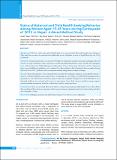Please use this identifier to cite or link to this item:
https://hdl.handle.net/20.500.14356/1256Full metadata record
| DC Field | Value | Language |
|---|---|---|
| dc.contributor.author | Thapa, Janak Kumar | - |
| dc.contributor.author | Pun, Asha | - |
| dc.contributor.author | Subedi, Raj Kumar | - |
| dc.contributor.author | Giri, Niraj | - |
| dc.contributor.author | Mahotra, Narayan Bahadur | - |
| dc.contributor.author | Sangroula, Raj Kumar | - |
| dc.date.accessioned | 2023-05-04T05:53:59Z | - |
| dc.date.available | 2023-05-04T05:53:59Z | - |
| dc.date.issued | 2020 | - |
| dc.identifier.citation | ThapaJ. K., PunA., SubediR. K., GiriN., MahotraN. B., & SangroulaR. K. (2020). Status of Maternal and Child Health Seeking Behavior among Women Aged 15-45 Years during Earthquake of 2015 in Nepal: A Mixed Method Study. Journal of Nepal Health Research Council, 18(2), 190-195. https://doi.org/10.33314/jnhrc.v18i2.2247 | en_US |
| dc.identifier.issn | Print ISSN: 1727-5482; Online ISSN: 1999-6217 | - |
| dc.identifier.uri | http://103.69.126.140:8080/handle/20.500.14356/1256 | - |
| dc.description | Original Article | en_US |
| dc.description.abstract | Abstract Background: Delivery of the maternal and child health services are generally affected during the time of disaster. This study aims to assess the maternal and child health service utilization in areas in Nepal affected by the 2015 earthquake. Methods: A mixed method study was carried in 29 Village Development Committees from nine earthquake-affected districts in Nepal. Quantitative data on maternal, neonatal and child health indicators before and after the earthquake were collected from the Health Management Information System. Focus group discussions and key informant interviews with different stakeholders were conducted to collect qualitative data. Quantitative data was analyzed using Microsoft Excel 2013. Qualitative data was analyzed manually using thematic analysis technique. Results: Most of the indicators were comparable before and after the earthquake. Indicators such as Bacille Calmette-Guerin vs. Measles-Rubella vaccine drop-out rate, 1st antenatal care visit, delivery by skilled birth attendant and 1st postnatal care visit within 24 hours of delivery improved after the earthquake. Though most of the health facilities were damaged, health services resumed under tents or in open spaces. Some of the common problems among pregnant women included stomachache, headache, malnutrition, diarrhea, and mental stress. Conclusions: There was not much effect in the delivery of maternal neonatal and child health services. This reflects the coordinated efforts from government as well as non-government organizations and civil societies during and after the earthquake in Nepal. Keywords: Earthquake; maternal and child health; Nepal; service delivery; service utilization. | en_US |
| dc.language.iso | en | en_US |
| dc.publisher | Nepal Health Research Council | en_US |
| dc.relation.ispartofseries | Apr-June, 2020;2247 | - |
| dc.subject | Earthquake | en_US |
| dc.subject | maternal and child health | en_US |
| dc.subject | Nepal; service delivery | en_US |
| dc.subject | service utilization | en_US |
| dc.title | Status of Maternal and Child Health Seeking Behavior among Women Aged 15-45 Years during Earthquake of 2015 in Nepal: A Mixed Method Study | en_US |
| dc.type | Journal Article | en_US |
| local.journal.category | Original Article | - |
| Appears in Collections: | Vol. 18 No. 2 Issue 47 Apr-Jun 2020 | |
Files in This Item:
| File | Description | Size | Format | |
|---|---|---|---|---|
| 2247-Manuscript-17513-1-10-20200911.pdf | Fulltext Download | 274.9 kB | Adobe PDF |  View/Open |
Items in DSpace are protected by copyright, with all rights reserved, unless otherwise indicated.
